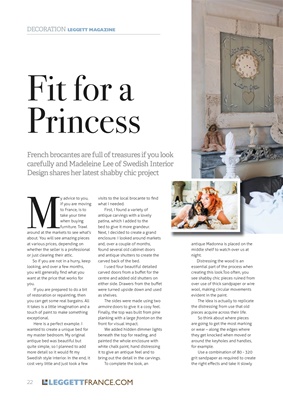
French brocantes are full of treasures if you look
carefully and Madeleine Lee of Swedish Interior
Design shares her latest shabby chic project
M
y advice to you,
if you are moving
to France, is to
take your time
when buying
furniture. Trawl
around at the markets to see what's
about. You will see amazing pieces
at various prices, depending on
whether the seller is a professional
or just clearing their attic.
So if you are not in a hurry, keep
looking, and over a few months,
you will generally fi nd what you
want at the price that works for
you.
If you are prepared to do a bit
of restoration or repainting, then
you can get some real bargains. All
it takes is a little imagination and a
touch of paint to make something
exceptional.
Here is a perfect example. I
wanted to create a unique bed for
my master bedroom. My original
antique bed was beautiful but
quite simple, so I planned to add
more detail so it would fi t my
Swedish style interior. In the end, it
cost very little and just took a few
Fit for a
Princess
visits to the local brocante to fi nd
what I needed.
First, I found a variety of
antique carvings with a lovely
patina, which I added to the
bed to give it more grandeur.
Next, I decided to create a grand
enclosure. I looked around markets
and, over a couple of months,
found several old cabinet doors
and antique shutters to create the
carved back of the bed.
I used four beautiful detailed
carved doors from a buff et for the
centre and added old shutters on
either side. Drawers from the buff et
were turned upside down and used
as shelves.
The sides were made using two
armoire doors to give it a cosy feel.
Finally, the top was built from pine
planking with a large fronton on the
front for visual impact.
We added hidden dimmer lights
beneath the top for reading, and
painted the whole enclosure with
white chalk paint, hand distressing
it to give an antique feel and to
bring out the detail in the carvings.
To complete the look, an
22
DECORATION LEGGETT MAGAZINE
antique Madonna is placed on the
middle shelf to watch over us at
night.
Distressing the wood is an
essential part of the process when
creating this look.Too often, you
see shabby chic pieces ruined from
over use of thick sandpaper or wire
wool, making circular movements
evident in the paint.
The idea is actually to replicate
the distressing from use that old
pieces acquire across their life.
So think about where pieces
are going to get the most marking
or wear - along the edges where
they get knocked when moved or
around the keyholes and handles,
for example.
Use a combination of 80 - 320
grit sandpaper as required to create
the right eff ects and take it slowly
LEGGETTFRANCE.COM